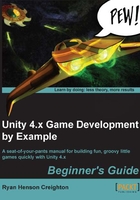
Time for action – add the Paddle
We'll borrow a term from Pong by naming our hittable surface paddle. The paddle will be the thing the player uses to bounce the ball and keep it up in the air. We can build the paddle using Unity's built-in Cube primitive, like we did with the Sphere.
- In the menu, navigate to GameObject | Create Other | Cube, as shown in the following screenshot:

Now, according to Hierarchy, we have three instances of GameObject in our Scene: the Ball, a Cube, and the Main Camera. Let's rename our Cube to remind us what it will do in the game:
- If the Cube is not selected, click on its name in the Hierarchy panel and rename it
Paddle:
Now, we should make the Paddle more paddle-like by changing the Scale properties of the Transform component.
- Make sure that the Paddle is still selected in the Hierarchy panel.
- In the Inspector panel, change the X Scale value of the Paddle to
1.1.
- Change the Y Scale value of the Paddle to
0.04. - Make sure the Position values are zeroed out to move the Paddle to the origin.

Ah, that's better! The Paddle looks like a thin, flat, smackable surface—perfect for whacking around our Ball.
What's a Mesh?
Although technology is constantly changing, most often a piece of 3D artwork comprises three types of pieces: vertices, edges, and faces. A vertex is a point in 3D space. The Paddle that we just added has eight vertices (points)—one on each corner. In these illustrations, we'll depict a cube mesh to make this easier to grasp:

Edges connect the dots—building lines between the vertices. Our Paddle has 12 visible edges: four along the top, four along the bottom, and four edges at each corner connecting the top and bottom.

Faces are surfaces that are drawn between (usually) three vertices. Our Paddle has six faces, like a die. Edges help define where one face ends and another begins:

Each face in our Paddle actually has a hidden edge splitting it up into two triangles. So, the Paddle is made up of 6 x 2 = 12 triangles:

3D models, then, are made up of three-sided (or sometimes four- or more-sided) surfaces. A multisided shape is called a polygon. When you hear someone say "polygon count", he's talking about the number of triangles that make up a 3D model. The fewer the polygons, the less work the computer needs to do to render, or draw, the model. That's why you may have heard that game artists need to produce low-polygon (or "low-poly") count models, while film and teevee artists are free to produce high-poly count models. In film or teevee, a shot only has to be rendered once before it's committed to a frame of the movie forever. But video game engines such as Unity have to constantly draw and redraw models on the fly. The fewer the polygons, the faster the game will potentially run.
A low-polygon model looks more crude and roughly hewn than a high-polygon model. As video games are built for better and faster systems, the models start featuring higher polygon counts. Compare the character models in a game such as Half-Life with the higher-polygon count models in the game's sequel, which requires a faster computer to run it. The difference is clear!

Poly wants to crack your game performance?
The number of polygons that Unity can handle in a single Scene really depends on the hardware that's running your game. Unity games are hardware-accelerated—the faster the machine that runs your game, the more polygons you can push. The best thing to do is to build your models with as few polygons as you can get away with, without making your game a giant cube-fest (unless you're making Minecraft, in which case, more power to you). Decide on a minimum system specification, then test early and often on that minimally-powered system to ensure that your game actually runs!
Of course, it entirely depends on your game, but you might try staying between 1,500 and 4,000 triangles per mesh to keep things humming.
Keep in mind that a number of factors beyond polygon count determine how quickly or slowly your game runs. Learning how to put together a lean, mean, and optimized game is something you'll learn over time as you gain experience as a game developer.
When you bring a 3D model into Unity from another program (as you'll be doing later in this book), Unity converts the model's "whatever-gons" into triangles. When you read about model architecture in Unity, "triangles" is the term that crops up most often.